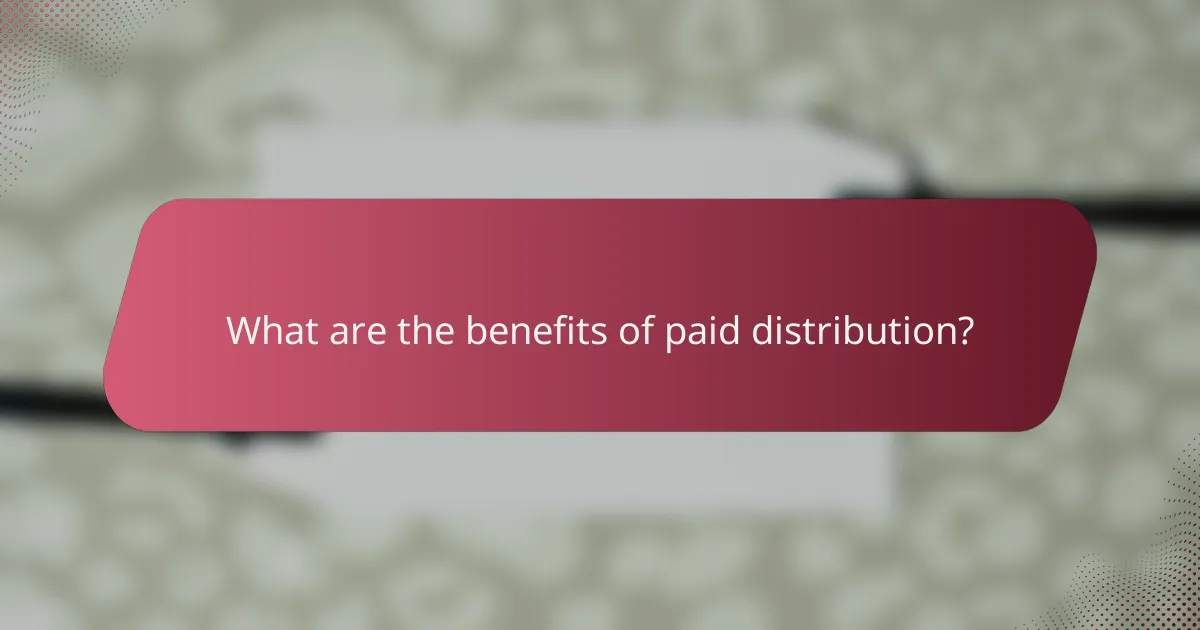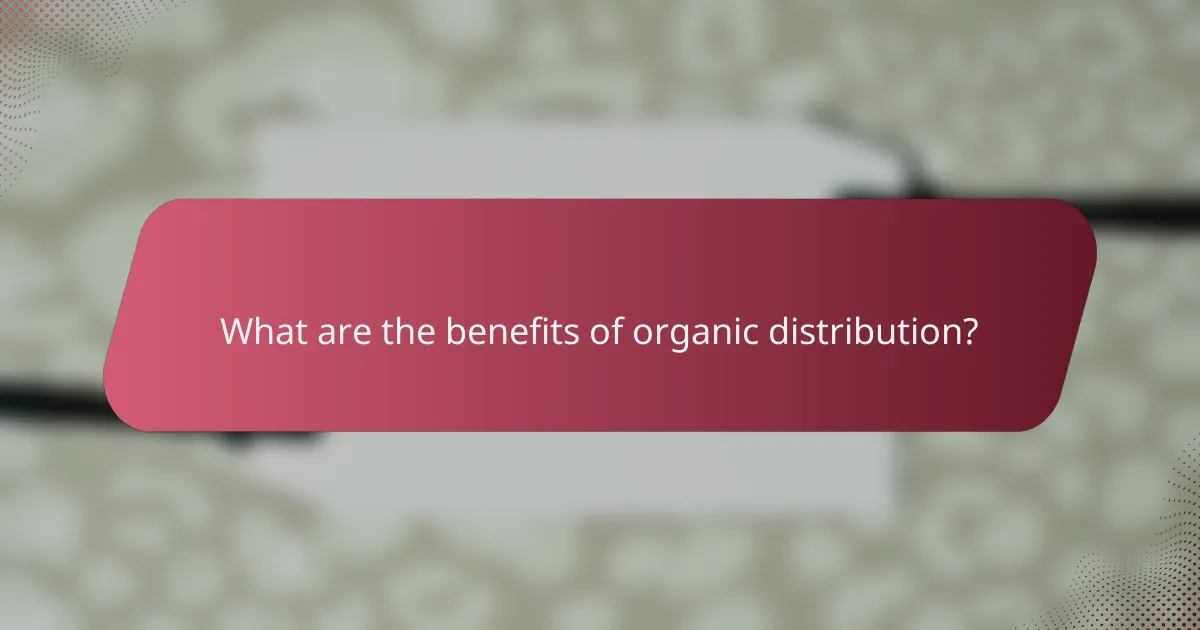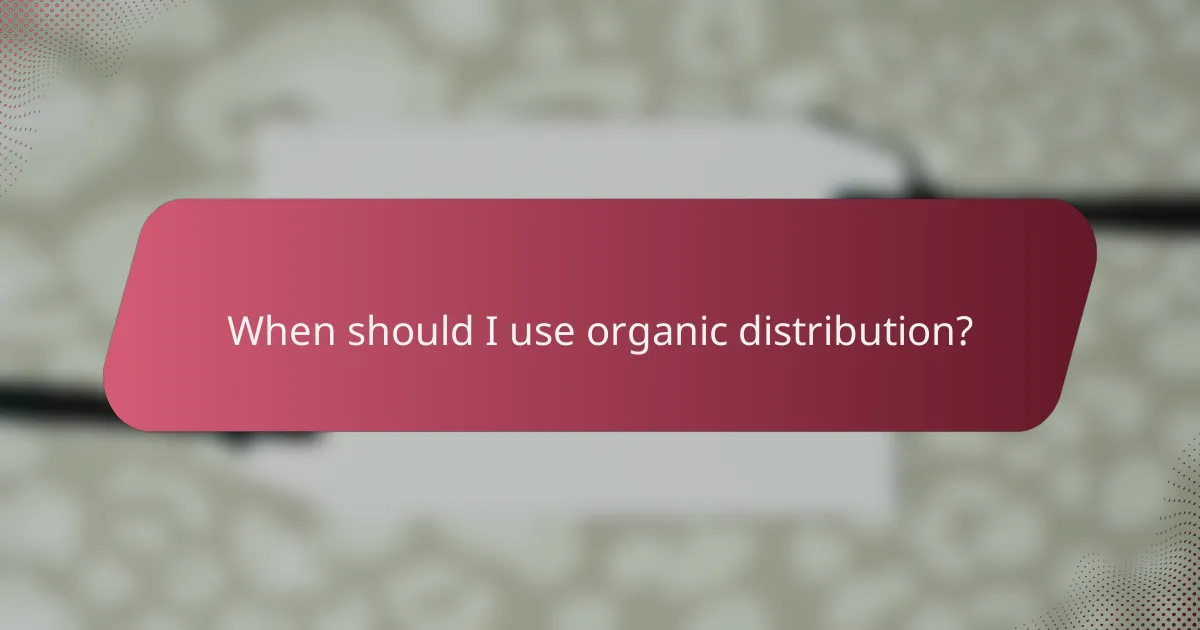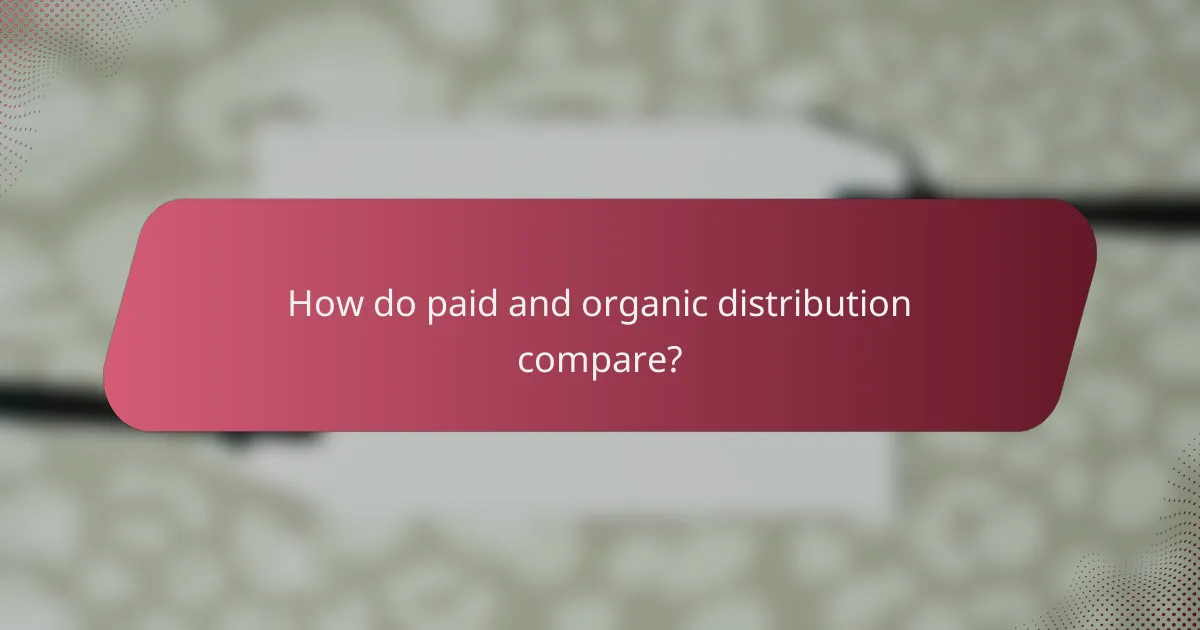In the digital marketing landscape, choosing between paid and organic distribution is crucial for maximizing content reach and effectiveness. Paid distribution provides immediate visibility and targeted audience engagement, making it suitable for short-term goals. Conversely, organic distribution fosters long-term growth and trust, ideal for building a sustainable online presence. Understanding when to leverage each strategy can significantly impact your overall marketing success.

What are the benefits of paid distribution?
Paid distribution offers several advantages, including immediate visibility, targeted audience reach, and the ability to track performance effectively. These benefits make it a valuable strategy for businesses looking to enhance their online presence and drive conversions.
Immediate visibility
Paid distribution provides instant visibility for your content, allowing it to appear prominently in search results or social media feeds. Unlike organic methods, which can take time to build momentum, paid campaigns can generate traffic almost immediately after launch.
This immediacy is particularly beneficial for time-sensitive promotions or product launches, where quick engagement is crucial. Businesses can leverage platforms like Google Ads or Facebook Ads to ensure their messages reach users right away.
Targeted audience reach
With paid distribution, you can precisely target specific demographics, interests, and behaviors. This capability allows you to tailor your campaigns to reach the audience most likely to engage with your content or make a purchase.
For example, if you’re selling outdoor gear, you can target users interested in hiking, camping, or outdoor activities. This targeted approach often results in higher conversion rates compared to more general outreach methods.
Performance tracking
Paid distribution enables detailed performance tracking through analytics tools. You can monitor key metrics such as click-through rates, conversion rates, and return on investment (ROI) in real-time.
This data allows businesses to assess the effectiveness of their campaigns and make informed adjustments. For instance, if a particular ad is underperforming, you can quickly change the messaging or targeting to improve results.
Scalability
Paid distribution is highly scalable, meaning you can adjust your budget and reach based on your goals. Whether you want to increase your spending for a larger audience or maintain a smaller budget for niche targeting, paid campaigns can adapt accordingly.
This flexibility is essential for businesses of all sizes, allowing startups to test the waters without significant investment while enabling larger companies to expand their reach rapidly when needed.
Brand awareness
Investing in paid distribution can significantly enhance brand awareness. By consistently appearing in front of your target audience, you can build recognition and trust over time.
For instance, running display ads across various platforms can keep your brand top-of-mind for potential customers. This increased visibility not only drives immediate traffic but also fosters long-term loyalty as users become familiar with your offerings.

What are the benefits of organic distribution?
Organic distribution offers several advantages, including cost-effectiveness, long-term visibility, and enhanced trust with audiences. These benefits make it a crucial strategy for businesses looking to build a sustainable online presence.
Cost-effectiveness
Organic distribution is generally more cost-effective compared to paid methods. While it may take time to build momentum, the ongoing costs are significantly lower once content starts to rank well in search engines. Businesses can save on advertising budgets and allocate resources to other areas.
Investing in quality content and SEO practices can yield high returns without the continuous expenditure associated with paid ads. This makes organic distribution an attractive option for startups and small businesses with limited budgets.
Long-term results
Organic distribution tends to produce long-lasting results. Once content ranks well, it can continue to attract traffic over months or even years without additional costs. This contrasts with paid distribution, where visibility ends once the budget is exhausted.
By focusing on evergreen content that addresses ongoing audience needs, businesses can create a steady stream of visitors. This approach not only enhances brand visibility but also builds a foundation for future marketing efforts.
Trust and credibility
Content that ranks organically is often perceived as more trustworthy by users. People tend to trust search engine results more than paid advertisements, which can lead to higher click-through rates. Establishing credibility is essential for building a loyal customer base.
By consistently providing valuable and relevant content, brands can position themselves as industry leaders. This trust can translate into increased customer loyalty and repeat business, which are vital for long-term success.
Higher engagement rates
Organic distribution typically results in higher engagement rates compared to paid methods. Users who find content through organic search are often more interested and invested in the material. This leads to longer time spent on pages and lower bounce rates.
Engaged users are more likely to share content, comment, and interact with the brand, which further amplifies reach and visibility. Creating compelling, informative content is key to fostering this level of engagement.
Sustainable traffic
Organic distribution can generate sustainable traffic over time. Unlike paid campaigns that require constant funding, organic traffic continues to flow as long as the content remains relevant and well-optimized. This creates a stable foundation for website growth.
To maintain this traffic, businesses should regularly update and optimize their content based on changing trends and audience preferences. This proactive approach ensures that organic distribution remains effective and continues to attract visitors consistently.

When should I use paid distribution?
Paid distribution is ideal when you need immediate visibility and reach for your content. It allows for targeted promotion to specific audiences, making it effective for various marketing objectives.
Launching new products
When launching new products, paid distribution can create buzz and drive initial sales. It enables you to reach potential customers quickly through targeted ads on social media, search engines, or other platforms.
Consider allocating a budget for pay-per-click (PPC) campaigns or sponsored posts to ensure your product gains traction. A well-timed paid campaign can significantly enhance your product’s visibility in a crowded market.
Time-sensitive promotions
For time-sensitive promotions, such as seasonal sales or limited-time offers, paid distribution is crucial for maximizing exposure. It allows you to quickly inform your audience about the promotion and drive immediate action.
Utilize platforms that allow for rapid deployment of ads, ensuring your message reaches consumers before the promotion ends. A clear call-to-action in your ads can help convert interest into sales effectively.
Targeting competitive keywords
When competing for high-traffic keywords, paid distribution can help you secure visibility against established competitors. Using paid search ads allows you to appear at the top of search results for specific terms, driving targeted traffic to your site.
Consider using tools to identify competitive keywords and set a budget for your campaigns. This strategy can be particularly effective in industries where organic reach is challenging due to high competition.

When should I use organic distribution?
Organic distribution is ideal when you aim to build long-term engagement and credibility without immediate financial investment. It works best for brands looking to establish authority and foster a loyal audience over time.
Building brand authority
Organic distribution helps in building brand authority by providing valuable content that resonates with your target audience. When users find your content helpful and informative, they are more likely to trust your brand and share it with others.
To enhance your authority, focus on creating high-quality, relevant content that addresses the needs and interests of your audience. This can include blog posts, videos, and social media updates that showcase your expertise in your industry.
Long-term content strategies
Using organic distribution aligns well with long-term content strategies that prioritize sustainability over quick wins. By consistently producing valuable content, you can improve your search engine rankings and attract organic traffic over time.
Consider developing a content calendar that outlines topics, formats, and posting schedules. This approach helps maintain consistency and ensures that your content remains relevant and engaging for your audience.
Cost-sensitive campaigns
Organic distribution is particularly beneficial for cost-sensitive campaigns, as it requires minimal financial investment compared to paid advertising. This makes it an attractive option for startups and small businesses with limited budgets.
To maximize your organic reach without incurring costs, leverage social media platforms, optimize your website for SEO, and engage with your audience through newsletters and community forums. These strategies can help you gain visibility and traction without significant expenses.

How do paid and organic distribution compare?
Paid distribution involves using financial resources to promote content, while organic distribution relies on natural reach through search engines and social media. Each method has distinct advantages and considerations, making them suitable for different marketing strategies.
Understanding paid distribution
Paid distribution refers to any promotional efforts that require a monetary investment, such as pay-per-click (PPC) advertising, sponsored posts, or social media ads. This approach allows for immediate visibility and can target specific demographics effectively.
When using paid distribution, consider your budget and the potential return on investment (ROI). It’s crucial to monitor performance metrics to ensure that your spending translates into desired outcomes, such as clicks or conversions.
Understanding organic distribution
Organic distribution encompasses methods that generate traffic without direct payment, primarily through search engine optimization (SEO) and social media engagement. This approach builds long-term visibility and credibility but typically requires more time to yield results.
To enhance organic distribution, focus on creating high-quality, relevant content that resonates with your audience. Utilize SEO best practices to improve your content’s ranking in search results, which can lead to sustained traffic over time.
When to use each method
Choose paid distribution when you need quick results or are launching a new product. It’s particularly effective for time-sensitive promotions or events where immediate visibility is crucial.
Organic distribution is ideal for building brand authority and long-term engagement. If you have the time to invest in content creation and optimization, this method can lead to sustainable growth without ongoing costs.
Key trade-offs
The primary trade-off between paid and organic distribution is cost versus time. Paid methods can deliver fast results but require ongoing investment, while organic strategies are cost-effective but may take longer to establish traction.
Consider your business goals and resources when deciding which method to prioritize. A balanced approach that incorporates both paid and organic strategies can often yield the best results, leveraging the strengths of each.
